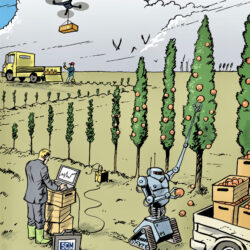How omnichannel can inspire a circular revolution

As omnichannel business models evolve in an extraordinary year, the public and private sector now have a really unique opportunity to build a circular economy.
By Carlos Cordon
When it comes to sustainability, shopping online divides opinion. Buying from Amazon or Alibaba means you are not driving to a physical store, but many of us buy single items online – and that’s clearly less efficient than buying several items in a mall. Whether you buy online or in store, the issue of packaging and waste – from polystyrene to end-of-life products – is the clearest obstacle to creating a circular economy.
This could all be about to change. The emergence of omnichannel means that the age of the circular economy – where materials and energy are reused to minimise the negative impact of economic activity – is within grasp. For companies, going circular makes sense – it creates efficiencies as well as good will. For consumers, it’s a chance to be part of the solution for a sustainable world. And for lawmakers, it provides an economic argument to enforce change.
The big question remains. How do we get products and packaging back to the companies of origin? Even in countries with highly-developed recycling systems, this process can be inefficient. Omnichannel enables companies to get closer to their ecosystem – from consumer to suppliers – and it is also opening up unprecedented possibilities for a circular economy.
World Clean Up Day
One example of how digital has made a difference is World Clean Up Day, which began in Estonia in 2008. Now a popular fixture in 180 countries, it brings together more than 20 million volunteers to clean up the planet for one day each year. World Clean Up Day encourages volunteers to use a smartphone app to take pictures and document waste dumped around their neighbourhood. This innovative use of technology offers a lesson for corporates and policymakers in how to embrace digital to drive changes in systems and behaviour. Perhaps most significantly, it shows us that people want to help and are prepared to contribute.
In some cases, for companies, the infrastructure is already there. Many fast-moving goods brands encourage their customers to register products online. This could be leveraged to build a stronger culture of recycling – offering consumers the means to return products instead of scrapping them, as companies like Apple already do. At the same time, consumer power – fuelled by social media – could be leveraged to put pressure on manufacturers to do more.
Here are the five key factors that will drive the circular economy revolution.
1. Public and private sectors must act together
Without the infrastructure in place, there can be no circular economy. This will require collaboration between the public and private sector to facilitate recycling within – not outside of – supply chains.
2. Don’t stigmatise plastic firms – empower them
It is easy to point the finger at plastic manufacturers. It makes more sense to bring them on board. They are the experts – and their futures depend on a more sustainable use of plastic.
3. The year of omnichannel
The COVID-19 pandemic has accelerated the uptake of omnichannel business models. Companies can piggy-back on this to embed the concept of circularity in their own ecosystems.
4. People power
Technology can harness diverse people power through crowdsourcing and crowdfunding. This digital ‘hive mind’ represents a huge resource of individuals willing to drive change on a personal, corporate and legislative level.
5. Something’s burning
You need a burning platform to change behaviour. With climate change and a pandemic, the opportunity to redesign the global economy has arrived.
Carlos Cordon is Professor of Strategy and Supply Chain Management at IMD Business School in Lausanne.










